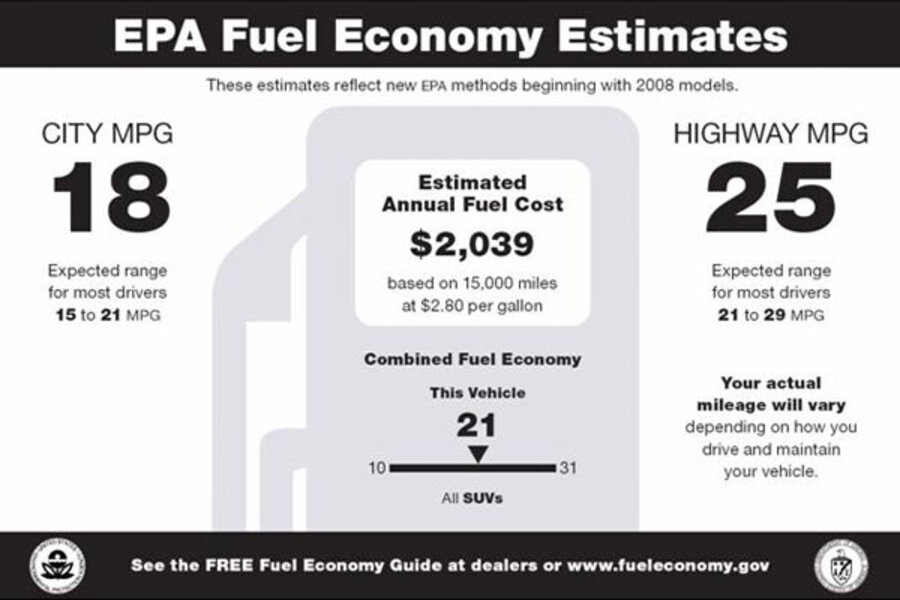Will smart-phone friendly mileage stickers help car buyers make smarter choices?
Loading...
Amid soaring gasoline prices, the Obama administration Wednesday unveiled new fuel-efficiency labels to appear on 2013 vehicle models that feature a host of new comparison points on mileage and will even enable smart-phone users to scan labels and compare multiple vehicles as they tromp through showrooms.
Touting it as the biggest-ever overhaul of the 35-year old labeling system, the evaluation system developed jointly by the Environmental Protection Agency and the Department of Transportation is supposed to help consumers compare a range of “next generation” vehicle technologies – hybrid, plug-in hybrid, all-electric, flex-fuel and natural-gas-powered vehicles – as well as traditional gasoline engines.
“Today’s car buyers want the best possible information about which cars on the lot offer the greatest fuel economy and the best environmental performance,” said the EPA administrator, Lisa P. Jackson. “The new labels provide comprehensive information to American car buyers, helping them make a choice that will save money at the gas pump and prevent pollution in the air we breathe.”
A Consumers Unions survey released Wednesday found 62 percent of car owners would consider better fuel economy as a key attribute in their next new car, with 58 percent saying they would pay more for a car that used less fuel.
While development of the new mileage label was mandated by Congress in 2007, the Obama administration in its 2010 ruling on fuel economy required the biggest boost in energy efficiency of cars and trucks in decades. According to the administration, vehicles built in model years 2012 through 2016 should save the nation 1.8 billion barrels of oil over the lifetime of the vehicles, and a vehicle purchased in 2016 would save its owner an average of $3,000 in fuel costs over its lifetime.
Comparing new-technology cars
The new labels, for instance, feature new ways to compare energy use and cost between new-technology cars that use electricity and conventional cars that are gasoline-powered. For instance, for plug-in hybrid vehicles, an illustration on the label shows how much the vehicle can go just on battery power – and then on gasoline – and gives mile-per-gallon equivalents for electricity used.
The labels also offer:
• Useful estimates on how much consumers will save or spend on fuel over the next five years compared to the average new vehicle. While the old label included an “estimated annual fuel cost” the new label will include how much is saved over five years as well as annually on fuel.
• Easy-to-read ratings (similar to Energy Star ratings on appliances) of how a model compares to all others for smog emissions and emissions of pollution that contribute to climate change. Two bars offer a 1-10 scale for smog and for greenhouse gas emissions – and place the vehicle's performance on that.
• An estimate of how much fuel or electricity it takes to drive 100 miles. This is especially useful when comparing plug-in hybrid vehicles with one another since some hybrids use their gasoline engines along with their electric motors all the time – while others use electric motors all the time – and gasoline engines some of the time.
• Information on the driving range between charges and charging time of an electric vehicle.
• A scannable code allows smartphone users to tap online information – including special “apps” that let them compare fuel economy, environmental and energy factors on the fly. Consumers can also enter details about their commutes and driving behavior to get more exact data on fuel savings.
Loss of letter grade is mourned
While the Alliance of Automobile Manufacturers and groups like the Consumers Union and the American Automobile Association praised the administration for pushing ahead on new labels, some groups were at least a little bit unhappy.
One key feature – a school-like letter grade to help rate at a glance vehicles against their peers – was dropped. That, according to some groups, was due to pressure from manufacturers that didn't like the idea of unflattering letter grades appearing on some gas guzzling vehicles.
“At a time when the price of gasoline is causing pain at the pump, EPA’s decision to forego clear, letter-grade fuel efficiency labels is a missed opportunity,” said Michael Livermore, director of the Institute for Policy Integrity at New York University School of Law, a nonpartisan think-tank on law, environment, and consumers. “At the next opportunity, the agency should correct this error, reflect the latest studies on consumer behavior and select the clearer, letter-grade label design,” he said in a statement.
Dan Becker, who directs the Safe Climate Campaign at the Center for Auto Safety in Washington said that while the new window sticker “offers genuine improvements,” the administration’s decision is “deeply disappointing.”
The improvements include five-year gas savings and more information about pollution, but the administration’s decision to drop the clear letter grade “is a lemon.”
Praise from auto industry
But automakers hailed what they called the new label’s strongest feature: giving the nation a single reference point on fuel economy.
“While the decision to pass on a letter grade has been circulating for weeks, the news today is that EPA is requiring a single national fuel economy label (no more separate label for California),” Gloria Bergquist, a spokeswoman for the Alliance of Automobile Manufacturers, said in a statement.
The automakers were joined by other environmentalists who agreed it was a good move.
“Information is power – in this case, the power for Americans to choose the cleanest new cars,” said Nathan Willcox, Federal Global Warming Program Director for Environment America. “These new labels are an important step toward getting cleaner, more fuel-efficient cars on the road, which will cut air pollution and ease Americans’ pain at the pump.”






